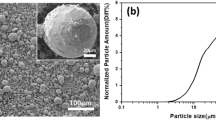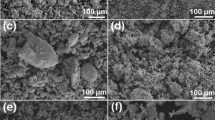Abstract
Microstructures of alloys with three compositions in the pseudobinary PbTe-Sb2Te3 system cast in copper molds using the injection molding technique were examined by scanning electron microscopy (SEM), energy-dispersive spectrometry, and X-ray diffraction (XRD). The microstructural length scales such as interlamellar spacing (ILS) and secondary dendrite arm spacing vary over two orders of magnitude, e.g., from 0.2 to 20 μm for SDAS in the hypereutectic alloy, depending on injection pressure, distance from surface, or thickness. The decrease in the microstructural length scale with the decrease in distance from the surface, thickness, and increase in injection pressure is attributed to an increase in the cooling rates estimated using the heat-transfer theory in solids. The difference in the injection pressures is represented as the difference in the heat-transfer coefficients.








Similar content being viewed by others
Notes
JEOL is a trademark of Japan Electron Optics Ltd., Tokyo.
PHILIPS is a trademark of FEI Company, Hillsboro, OR.
The regression lines for SDAS for alloy 3 and ILS for alloy 1 were determined because sampling numbers in the image analysis are larger for these alloys than for alloy 2 and, hence, the data for these alloys are supposed to be of better quality.
References
L.E. Bell: Science, 2008, vol. 321, pp. 1457–61.
C.B. Vining: Nat. Mater., 2009, vol. 8, pp. 83–85.
R. Venkatasubramanian, E. Siivola, T. Colpitts, and B. O’Quinn: Nature, 2001, vol. 413, pp. 597–602.
T.C. Harman, P.J. Taylor, M.P. Walsh, and B.E. LaForge: Science, 2002, vol. 297, pp. 2229–32.
G. Chen: 9th Intersoc. Conf. on Thermal and Thermomechanical Phenomena In Electronic Systems, IEEE Cat. No. 04CH37543, 2004, p. 8.
K.F. Hsu, S. Loo, F. Guo, W. Chen, J.S. Dyck, C. Uher, T. Hogan, E.K. Polychroniadis, and M.G. Kanatzidis: Science, 2004, vol. 303, pp. 818–21.
D.L. Medlin and G.J. Snyder: Curr. Opin. Coll. Int. Sci., 2009, vol. 14 (4), pp. 226–35.
T. Ikeda, S.M. Haile, V.A. Ravi, H. Azizgolshani, F. Gascoin, and G.J. Snyder: Acta Mater., 2007, vol. 55, pp. 1227–39.
T. Ikeda, L.A. Collins, V.A. Ravi, F.S. Gascoin, S.M. Haile, and G.J. Snyder: Chem. Mater., 2007, vol. 19, pp. 763–67.
T. Ikeda, V.A. Ravi, L.A. Collins, S.M. Haile, and G.J. Snyder: J. Electron. Mater., 2007, vol. 37, pp. 716–20.
T. Ikeda, V.A. Ravi, and G.J. Snyder: Acta Mater., 2009, vol. 57, pp. 666–72.
T. Ikeda, E.S. Toberer, V.A. Ravi, S.M. Haile, and G.J. Snyder: 26th Int. Conf. on Thermoelectrics, 2007.
N.K. Abrikosov, E.I. Elagina, and M.A. Popova: Inorg. Mater., 1965, vol. 1, pp. 1944–46.
T. Ikeda, V.A. Ravi, and G.J. Snyder: unpublished research.
P.E.J. Flewitt and R.K. Wild: Physical Methods for Materials Characterization, Institute of Physics Publishing, Bristol, United Kingdom, 1994, p. 283.
L.E. Shelimova, O.G. Karpinskii, T.E. Svechnikova, E.S. Avilov, M.A. Kretova, and V.S. Zemskov: Inorg. Mater., 2004, vol. 40, pp. 1264–70.
H.S. Carslaw, and J.C. Jaeger: Conduction of Heat in Solids, Clarendon, Oxford, United Kingdom, 1959, p. 122.
D.R. Poirier and E.J. Poirier: Heat Transfer Fundamentals, 1992, TMS, Warrendale, PA, p. 40.
E. Niiyama: Chuuzou Dennetsu Kougaku, Agne Gijutu Center, 2001, p. 210.
D. Bouchard and J.S. Kirkaldy: Metall. Mater. Trans. B, 1997, vol. 28B, pp. 651–63.
B. Chalmers: Principle of Solidification, 1964, Wiley, New York, NY.
Acknowledgments
This work was partly funded by the National Aeronautics and Space Administration (NASA) through the Jet Propulsion Laboratory (Pasadena, CA) and the Precursory Research for Embryonic Science and Technology (PRESTO) program of the Japan Science and Technology Agency (Tokyo).
Author information
Authors and Affiliations
Corresponding author
Additional information
Manuscript submitted July 6, 2009.
Appendix
Appendix
Figures A1 and A2 show the temperature variations with position and time, respectively, in a 3-mm-thick plate of a PbTe-Sb2Te3 alloy calculated for h = 500 and 60,000 Wm−2 K−1. Other physical quantities necessary in calculation were the same as those used in previous work.[8] The temperature gradient in the plate is steeper for h = 60,000 Wm−2 K−1 than for h = 500 Wm−2 K−1, as shown in Figure A1. Figure A2 shows that temperature decreases more rapidly with time for h = 60,000 Wm−2 K−1. Figure A2 also shows the cooling rates at the middle and at 10 and 100 μm from the surface in the plate. The cooling rates are higher in the initial stages of cooling and at positions closer to sample surface, reaching to the order of 106 Ks−1 for h = 60,000 Wm−2 K−1.
Temperature and cooling rate variation with time in a 3-mm-thick plate of a PbTe-Sb2Te3 alloy calculated using Eqs. [1a] through [1c] with the materials parameters used in previous work[8] for cases in which heat-transfer coefficients are h = (a) 500 Wm−2 K−1 and (b) 60,000 Wm−2 K−1. For distances in the figures, 10 μm (dotted line) and 100 μm (broken line), indicate distance from the surface
Rights and permissions
About this article
Cite this article
Ikeda, T., Ravi, V.A. & Jeffrey Snyder, G. Microstructure Size Control through Cooling Rate in Thermoelectric PbTe-Sb2Te3 Composites. Metall Mater Trans A 41, 641–650 (2010). https://doi.org/10.1007/s11661-009-0143-4
Published:
Issue Date:
DOI: https://doi.org/10.1007/s11661-009-0143-4






